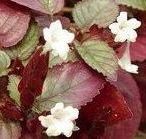Red ivy
(Strobilanthes alternata)

Description
Strobilanthes alternata (synonym Hemigraphis alternata), may be known as red ivy, red-flame ivy, or waffle plant, is a member of the family Acanthaceae native to Java. It is a prostrate plant with purple colored leaves. Strobilanthes alternata is a herb that grows near 30 cm (12 in) long. The stems of the plant are prostrate and purplish, especially at the nodes. The leaves are hairy and opposite, and one leaf of a pair is much larger than the other. The leaf blades are dark green on the top face and are lighter green or purplish on the lower face. The flowers of the plant grow from where the leaf meets the stem, and are white with purple penciling.You can call this plant by various names such as Cemetery plant, Purple waffle plant, Murikooti and Ayurveda addresses this plant as Vranaropani (meaning – wound healer). In Kerala, India, we call this herb as Muriyan pacha as it helps to heal wounds faster. This plant is native to the tropical regions of the globe especially tropical Malaysia and South East Asia. This natural herb grows in plenty across India, China, Indonesia, and Japan. In Indonesia, Strobilanthes alternata is used to promote urination, check and heal hemorrhages, stop dysentery, and treat venereal diseases. The plant is popular in the United States and rarely the United Kingdom to use in hanging baskets for gardens.The botanical name of Red flame ivy is Hemigraphis colorata Blume. Strobilanthes is a genus of about 350 species of flowering plants in the family Acanthaceae, mostly native to tropical Asia and Madagascar, but with a few species extending north into temperate regions of Asia. Many species are cultivated for their two-lipped, hooded flowers in shades of blue, pink, white and purple. Most are frost-tender and require protection in frost-prone areas. Strobilanthes atropurpurea is a temperate species, native to eastern Siberia; it is cultivated for its purple flowers. Strobilanthes dyeriana (Persian shield) is a tropical plant native to Myanmar. It is grown for its dark green foliage with bright, metallic-purple stripes radiating outward from the central leaf vein. In proper conditions, it will also produce pale purple flowers. Persian Shield grows best outdoors in USDA zones 9 and 10, although it can survive in other zones as a houseplant given sufficient temperature, soil moisture and humidity. It has gained the Royal Horticultural Society's Award of Garden Merit.
Taxonomic tree:







